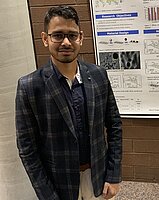Fabrication of Point of Use Treatment Systems for Aqueous Arsenic and their Evaluation

Tonoy K Das is a doctoral student in the Environmental and Conservation Sciences at North Dakota State University and this is my third year. I received by Bachelor’s degree in Agriculture from Bidhan Chandra Krishi Viswavidyalaya (India) in 2012. After that I was received a junior research fellowship from the Indian Council of Agriculture Research for pursuing my master’s degree. I got admission in Punjab Agriculture University and successfully completed my M.Sc. in Soil Science in 2014. My thesis on the water management cotton cultivation. After that in 2015, I joined Indian Agricultural Research Institute, (New Delhi, India) to work on a research project related to Enhancing Use Efficiency of Micronutrients by a Novel Delivery System. We designed a novel clay polymer composite to deliver plant micronutrients and evaluated nutrient use efficiency by different field crops.
Fabrication of Point of Use Treatment Systems for Aqueous Arsenic and their Evaluation
Research Abstract
Arsenic is carcinogenic pollutant that causes serious health problems. Arsenic in drinking water affects more than 140 million people globally. In this work, we are usin iron hybridized graphene oxide (GNZVI) as an effective adsorbent for aqueous arsenic removal. We have synthesized magnetite (M) or nanoscale zero-valent iron (NZVI) particles on GO sheets. The synthesized nanohybrids are characterized using Fourier transform infrared spectroscopy (FT-IR), X-ray diffractometry (XRD), scanning and transmission electron microscopy (SEM & TEM), and X-ray photoelectron spectroscopy (XPS). Arsenic removal capacity, adsorption isotherm, kinetics, and effects of environmental attributes (pH, temperature, the presence of other ions and compounds) are investigated and the findings are compared. GNZVI works very efficiently under relevant environmental conditions and has very high adsorption capacity. The possible mechanisms of arsenic removal by different graphene-supported iron nanoparticles are elucidated. The GNZVI nanohybrid has the potential for use in filter media development We will be investigating desorption pattern of arsenic saturated adsorbent (GNZVI) under different environmental conditions (pH, ORP, presence competitive ions, ionic strength, temperature) to make it more robust and applicable in the real world situations.
Research Highlights
Arsenic contamination of drinking water is a threat to public health due to its carcinogenicity, and affects more than 200 million people worldwide. We have developed a novel graphene-oxide iron-nanohybrid (GFeN) for aqueous arsenic removal (removal capacities of 306/431 mg/g for As(III)/As(V) and fast reaction kinetics). Graphene-oxide sheets play an important role in the removal process. We proposed an arsenic removal mechanism where graphene-oxide sheets were used in the nanohybrid work as electron storage units to help in reactivating the iron as well as reducing the arsenic species to the final zero-valent state. There were negligible interferences by co-existing ions, pH, temperature, and organic matters on arsenic removal by GFeN. High adsorbing GFeN poses a risk of release of the adsorbed arsenic, so we evaluated the stability of adsorbed arsenic. In the presence of competing anions and different pH, the nanohybrid showed minimal release. The adsorbed arsenic remained stable, and only ~6% of the adsorbed arsenic was released over a two-year period. Ultra-high arsenic adsorption capacity, quick removal, and stability of adsorbed arsenic make our nanohybrid a reliable and robust candidate for possible field application (as an adsorption medium). To ease the application of powdered GFeN in point-of-use treatment systems, we have synthesized polyethersulfone (PES) and cellulose nanofiber (CNF) based composite, which can successfully entrap the GFeN for efficient arsenic removal. This research is developing a feasible and sustainable arsenic treatment system that will be able to supply safe drinking water to the stakeholders.

Achintya Bezbaruah
Civil & Environmental Eng.
Office: Civil/Ind Eng 201G
Telephone: 701-231-7461
Email: a.bezbaruah@ndsu.edu


